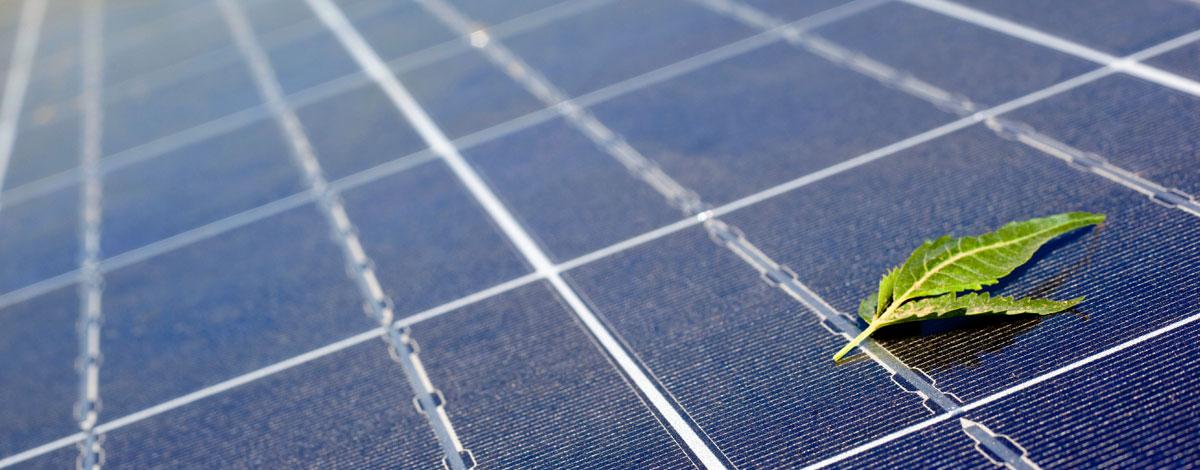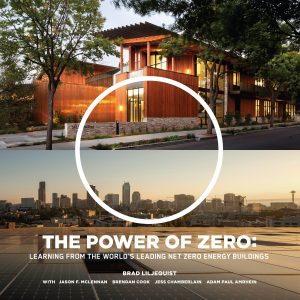We are a participant in the Amazon Services LLC Associates Program, an affiliate advertising program designed to provide a means for us to earn fees by linking to Amazon.com and affiliated sites.
Editor’s Note: The following excerpt is a chapter from “The Power of Zero,” released by Ecotone Publishing. Copyright © 2016. Reprinted with permission. All rights reserved.
Net Zero Energy — the first stage in a transformation toward a carbon-free future.
Net zero energy (NZE) buildings, though compelling and meaningful, are just a beginning. We are only in the earliest days of a revolution in net zero energy design and technology. The energy use intensity (EUI) of net zero energy buildings will continue to drop, the efficiency and output of renewable resources will increase, and the cost of design, construction and operation will decrease, making net zero energy projects more common. New net zero energy design ideas and technologies will evolve, and enable new pathways for achieving this vital concept. It is critical to understand, however, that net zero energy buildings, and even net zero energy communities, do not eliminate fossil fuel usage. Net zero energy buildings are not a universal solution—they are just a component. In order to free ourselves from fossil fuels, we need a deeply integrated revolution in buildings, transportation, and the power grid.
So what advancements are on the horizon?

David & Lucile Packard Foundation Headquarters, Los Altos, CA Photo: Courtesy of Jeremy Bitterman
Net Zero Energy Building and Designs — The Next Generation
The boundaries of passive and active systems blur.
As knowledge of net zero design spreads, the duality between “passive” and “active” approaches is fading. Net zero energy buildings are partially built on the heritage of passive solar buildings of the 1970s, which—at least from a heating and cooling standpoint—relied on simple thermal gain and storage. As the net zero revolution began, sophisticated technologies—for example, heat pumps and LED lighting—dominated the discussion.
Today, however, the best net zero energy buildings seamlessly combine both passive and active design concepts. In fact, it is becoming increasingly difficult to describe net zero energy buildings in those terms. For example, the Bullitt Center utilizes a highly sophisticated software program. Using real-time weather data to open and close windows depending on wind direction, the building is naturally cooled and ventilated based on thermal comfort needs. Windows also allow passive solar gain, but only during cooler months, and only if the computerized system opens the exterior shades. The passive solar gain typically contributes to only a portion of the building’s heat, which is supplemented by the heat pump system. Are these systems active or passive? Because they are thoughtfully designed with an attention to naturally occurring assets, these systems uproot traditional categorization. Moving into the future, sensitively designed systems that take maximum advantage of nature’s gifts will become the norm.
Micro heat pumps
The revolution in heat pump technology will continue, with a new focus on micro systems. Such systems allow appropriate load matching for buildings with excellent thermal envelopes that have low heating and cooling demand. Sanden, a major automobile heat pump and air conditioner manufacturer, recently entered the building market, suggesting a renewed interest in this sector.
Elimination of high-GWP compression gasses from heat pumps
Today, high global warming-potential compression gasses, such as hydrofluorocarbons (HFCs), are used in heat pumps. These substances have the potential to leak, creating an additional impact on the climate. The shift from combustion- to heat pump-based heating systems must be accompanied by a shift to CO2 as the primary compression gas for heat pumps, lest we simply replace one problematic gas for another. Thankfully, this shift away from global warming-causing compression gasses has begun.
High-performance windows become the norm
Windows that are typically used in net zero energy buildings, with U-values in the 0.20s, are fairly custom, though they have high price tags. However, as glazing and window technology matures, and especially as jurisdictions begin to codify lower U-values for the purpose of energy management, these windows will become much more prevalent, similar to the switchover to low-E glass that happened a decade ago.
Dedicated focus on high energy use sectors
Certain very high EUI building types—hospitals, restaurants, factories, data centers, and supermarkets in particular—lag behind other sectors in the adoption of innovative technologies. These commercial buildings use vastly more energy per square foot than primary buildings like homes and offices. The energy modeling for one potential net zero energy building found that heat from refrigerators to went outdoors, instead of using it resourcefully for internal heating. In restaurants, stoves are often run at one hundred percent despite the actual need, and the heat pump revolution has yet to arrive to kitchen equipment. Technologies such as CO2 heat pumps, which produce much higher-temperature water than conventional heat pumps, suggest that new approaches are on the horizon.
Revolution in retrofit technologies
Shy of a complete building overhaul, it can be challenging to deeply retrofit a building for very low energy use. However, strides are being made to streamline the retrofit process and reduce costs. Thermal imaging cameras, a critical tool in understanding building heat and cold leakage, are now radically cheaper, and soon should become a standard toolbox item. Heat recovery ventilators, an obscure and rarely seen item in the past, are now available readily available and significantly cheaper than before. Further,the introduction of vacuum insulation panels, from manufacturers such as Panasonic, offer extremely high R-values per inch.
Revolution in building-mounted renewables
The cost of solar panels has been dropping significantly, suggesting a maturing of the technology, and other elements of solar installation are coming to the fore as the technology becomes more commonplace. Better integration of solar applications during the design process, particularly to facilitate mounting, will bring solar costs down even further. At the same time, panel efficiency continues to increase—just several years ago, 15 percent was standard. Today, twenty percent is now available in the marketplace, while 40 percent has been achieved in laboratory conditions. These performance improvements may seem small, but improvements average about five percent each year, which is quite significant over time.
A much deeper revolution in solar generation is brewing with thin-film, omnidirectional solar cells. Ideally these will absorb the sun’s energy with less regard for solar angle, and will be installed as a wrapped skin, perhaps in lieu of paint. This technology will transform building energy generation again, with much higher levels of building production because panels can be placed in a much broader array of locations, including walls.
Revolution in energy storage
Finally, Tesla and the automotive sector are leading an ongoing transformation in electrical storage. This technology brings us back to the roots of net zero buildings—the off-the-grid passive buildings of the 1970s. This technology could significantly decrease the electric grid as individual buildings become more autonomous in their use and production of energy.

Authored by Brad Liljequist



